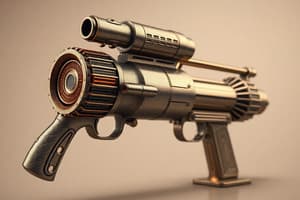Podcast
Questions and Answers
What characteristic of a laser beam ensures it has parallel rays?
What characteristic of a laser beam ensures it has parallel rays?
- Wide wavelength spectrum
- High intensity fluctuation
- Coherence (correct)
- Multiple color variations
What do the indices p and l in TEMpl indicate about the laser mode?
What do the indices p and l in TEMpl indicate about the laser mode?
- Number of zero-intensity nodes (correct)
- Energy consumption of the laser
- Frequency of the laser oscillations
- Color variation of the beam
How is the intensity distribution of a TEMpl described mathematically?
How is the intensity distribution of a TEMpl described mathematically?
- By a Fourier transform
- Using a Laguerre polynomial equation (correct)
- By a sinusoidal function
- Through Poisson's equation
Which of the following does NOT affect the radius of the laser beam, rl?
Which of the following does NOT affect the radius of the laser beam, rl?
What aspect of laser operation do mirrors in the resonator enhance?
What aspect of laser operation do mirrors in the resonator enhance?
What is the significance of the beam quality factor, M2, in laser applications?
What is the significance of the beam quality factor, M2, in laser applications?
In the context of laser technology, what does TEM00 represent?
In the context of laser technology, what does TEM00 represent?
Which equation represents the laser net power, Pl, in terms of intensity?
Which equation represents the laser net power, Pl, in terms of intensity?
What does an M2 value of 1 indicate about a laser beam?
What does an M2 value of 1 indicate about a laser beam?
Which statement is true regarding the relationship between M2 and beam shape?
Which statement is true regarding the relationship between M2 and beam shape?
What is the approximate depth of focus for a beam with a 28° angle of divergence?
What is the approximate depth of focus for a beam with a 28° angle of divergence?
Which of the following is a typical heat source for thermal metal powder bed additive manufacturing aside from laser beams?
Which of the following is a typical heat source for thermal metal powder bed additive manufacturing aside from laser beams?
What characteristic differentiates electron beams from lasers in terms of energy?
What characteristic differentiates electron beams from lasers in terms of energy?
Which of the following is not typically classified as a component of a laser system?
Which of the following is not typically classified as a component of a laser system?
In laser additive manufacturing, which parameter is most critical to determine the quality of the laser beam?
In laser additive manufacturing, which parameter is most critical to determine the quality of the laser beam?
What is a common industrial application of fiber lasers?
What is a common industrial application of fiber lasers?
Which of the following statements about semiconductor diode lasers is true?
Which of the following statements about semiconductor diode lasers is true?
What is a key advantage of fiber lasers in industrial applications?
What is a key advantage of fiber lasers in industrial applications?
In fiber optic laser technology, which component is crucial for generating the laser light?
In fiber optic laser technology, which component is crucial for generating the laser light?
Which type of pump source is commonly used with solid-state lasers?
Which type of pump source is commonly used with solid-state lasers?
Which of the following characteristics is true regarding laser beams?
Which of the following characteristics is true regarding laser beams?
What defines the output of a Q-switched laser?
What defines the output of a Q-switched laser?
Which laser type utilizes gas as the active medium?
Which laser type utilizes gas as the active medium?
What is the primary characteristic of fiber lasers in comparison to solid-state lasers?
What is the primary characteristic of fiber lasers in comparison to solid-state lasers?
Study Notes
Laser Additive Manufacturing
- Lasers are used in laser powder bed fusion (LPBF) and laser directed energy deposition (LDED)
- Laser beams are coherent, monochromatic, and collimated (extremely parallel rays)
- Lasers have a medium that is placed in a cavity or resonator with two parallel mirrors at each end to amplify light
- Mirrors create transverse modes superimposed on the beam, known as transverse electromagnetic modes (TEM)
- The number of zero-intensity nodes transverse to the beam axis in the radial and tangential directions are indicated by p and l, respectively
- For TEM00, p and l are zero, representing the lowest order with a Gaussian beam shape
- Different TEM modes have different energies and patterns
- The intensity distribution of a TEMpl at a point (r, φ) (in polar coordinates) from the mode Centre is described by the Laguerre equation
- Laguerre polynomials are expressed by one of two equations based on indices
- The waist's beam radius is r20𝑙, its location along the propagation axis is z0, and the far-field divergence angle is θ
- The beam quality factor M2, or the beam propagation factor Q, describes the beam propagation and are related as
- The medium's laser wavelength λ and the reflection index is n
- The laser beam is Gaussian if k= M2 = 1, whereas it is not Gaussian if M2 > 1
- The larger the M2, the beam shape will become similar to a flat hat
- The depth of focus "parameter in a parabolic beam profile refers to a segment of the beam that can be assumed to have a cylindrical shape
- The depth of focus for a 28° angle of divergence is reported to be approximately 1.05r0l
Electron Beam Additive Manufacturing
- The electron beam (EB or EBM) is a typical heat source for thermal metal powder bed additive manufacturing
- EB is a collimated stream of free electrons that is helpful for heating and welding
- EBs are used in micro- and nanoscopy, machining, and spectroscopy
- EB can be used for cutting, machining, and welding
- EB are very coherent and have low numerical intensity sources of high kinetic energy
- Lasers have high numerical intensity sources of low energy photons
Types of Laser and Components
- The first CW laser was a helium–neon laser with 1153 nm
- Since then, gas lasers, solid-state lasers, and dye lasers have been developed
- Lasers can be classified by different parameters, but most are categorized by the active medium
- Lasers are grouped as follows:
- Solid-State Laser
- Gas Lasers
- Liquid Dye Lasers
- Semiconductor Diode Lasers
- Fiber Lasers
- These lasers can produce coherent light at different wavelengths
- The output beam can be continuous (CW) or pulsed
Solid-State Lasers
- The gain medium is solid at room temperature
- In 1960, a solid-state ruby laser (Cr3+- Al2O3) was invented
- The first laser used Cr3+ impurities
- Most solid-state lasers embed a dopant in a host material
- Neodymium (Nd3+) is a common dopant in commercial lasers
- Yttrium orthovanadate (YVO4), and yttrium lithium fluoride (YLF), and yttrium aluminum garnet are popular host materials (YAG)
- Solid-state lasers operate at different wavelengths depending on dopant and host materials
- Doped YAG and YLF produce laser beams with 1064.1 and 1054.3 nm wavelengths
- Ti3+ dopant ions in Al2O3 produce a 780 nm laser
- The ruby laser is 694.3 nm
Nd:YAG Solid-State Laser
- Neodymium (Nd) and CO2 lasers are the most common in AM
- This solid-state laser uses Nd-doped host crystals as gain media
- Host materials include yttrium aluminum garnet (YAG, Y3Al5O12) and glass
- Host crystal determines laser emission wavelengths.
Questions
- Make a list of different types of laser used in metal additive manufacturing
- Google and find post-processing done in metal additive manufacturing with the help of lasers.
Studying That Suits You
Use AI to generate personalized quizzes and flashcards to suit your learning preferences.
Related Documents
Description
Explore the fundamentals of Laser Additive Manufacturing, including the principles of laser powder bed fusion and directed energy deposition. Learn about the characteristics of laser beams and their transverse electromagnetic modes, as well as the significance of Laguerre polynomials in beam intensity distribution.




